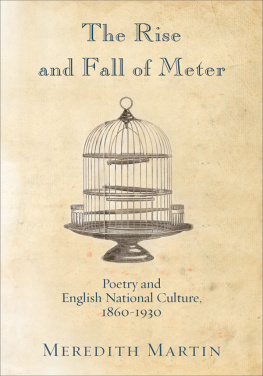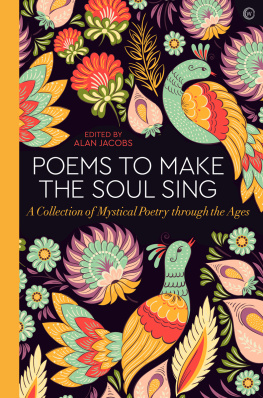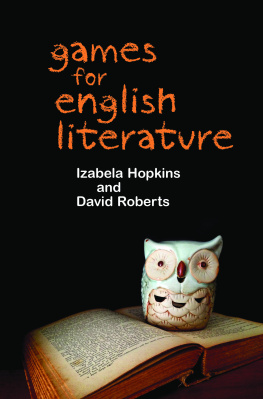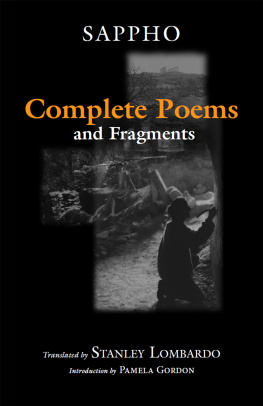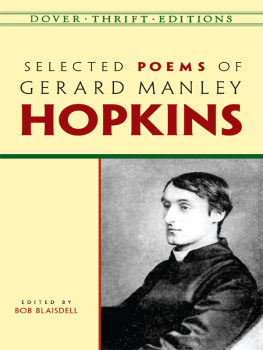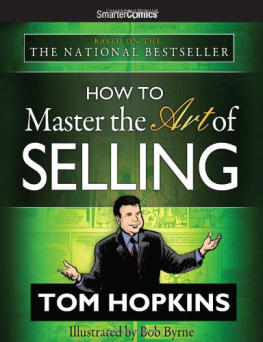Gerard Manley Hopkins [Hopkins - Poems
Here you can read online Gerard Manley Hopkins [Hopkins - Poems full text of the book (entire story) in english for free. Download pdf and epub, get meaning, cover and reviews about this ebook. year: 2014, publisher: William Ralph Press, genre: Science. Description of the work, (preface) as well as reviews are available. Best literature library LitArk.com created for fans of good reading and offers a wide selection of genres:
Romance novel
Science fiction
Adventure
Detective
Science
History
Home and family
Prose
Art
Politics
Computer
Non-fiction
Religion
Business
Children
Humor
Choose a favorite category and find really read worthwhile books. Enjoy immersion in the world of imagination, feel the emotions of the characters or learn something new for yourself, make an fascinating discovery.

- Book:Poems
- Author:
- Publisher:William Ralph Press
- Genre:
- Year:2014
- Rating:3 / 5
- Favourites:Add to favourites
- Your mark:
- 60
- 1
- 2
- 3
- 4
- 5
Poems: summary, description and annotation
We offer to read an annotation, description, summary or preface (depends on what the author of the book "Poems" wrote himself). If you haven't found the necessary information about the book — write in the comments, we will try to find it.
Gerard Manley Hopkins [Hopkins: author's other books
Who wrote Poems? Find out the surname, the name of the author of the book and a list of all author's works by series.
Poems — read online for free the complete book (whole text) full work
Below is the text of the book, divided by pages. System saving the place of the last page read, allows you to conveniently read the book "Poems" online for free, without having to search again every time where you left off. Put a bookmark, and you can go to the page where you finished reading at any time.
Font size:
Interval:
Bookmark:
Copyright 2014 by William Ralph Press
www.williamralphpress.com
All rights reserved. No part of this book may be reproduced in any form or by any electronic or mechanical means, including information storage and retrieval systems, without permission in writing from the publisher, except by a reviewer, who may quote brief passages in a review. Any other request to reprint, copy or quote should be submitted in writing to William Ralph Press.
ISBN: 978-1-932023-45-9
First E-Edition
Poems Copyright 2104 by William Ralph Press.
So much has been written about Gerard Manley Hopkins (1844-1889), the brilliant Victorian Jesuit wholike Emily Dickinsonwrote poetry in relative obscurity, it seems redundant to once again explain how and why his importance, originality and influence loom so large over modern verse. Regardless of the how and the why, the sheer joy in reading these poems in and of themselves for the ebullience they instill as one hears them in ones own mouth, chest and voice is the aim and hope of this editors humble collection. Hopkins verse sings with such prosodic precision that one cannot help but be drawn into the sonic world that it creates coupled with brightly painted images that tell of the simple yearnings of those two emotionsso similar in naturethat define lives of deep awareness: ecstasy and despair. Much has been argued over the years about Hopkins prosodic theory of sprung rhythm, though most of it is simply theory, speculation and superfluous explanationwhat one can certainly take away from it is that, like the recluse of Amherst, he uses a powerful style to create an inimitable utterance that he uses to an utterly brilliant advantage and subsequently has become one of English languages great poetic stylists and one of human imaginations most astute scribes. I present his own preface to his Poems as sufficient explanation of his technical ideas. Unlike Dickinson, he wrote sparingly, and what verse he managed is presented here in addition to his preface. While brief, it is some of the most powerful and dense poetry ever wrought and requires re-readings and a certain amount of meditation to be fully felt, though the experience it createsunlike any other poet before or aftertouches one so uniquely that it spills into the readings of other writers hereafter. Thank you for your patronage, and I hope you enjoy these poems as much as I do.
Neil Azevedo (8/24/14)
The poems in this book are written some in Running Rhythm, the common rhythm in English use, some in Sprung Rhythm, and some in a mixture of the two. And those in the common rhythm are some counterpointed, some not.
Common English rhythm, called Running Rhythm above, is measured by feet of either two or three syllables and (putting aside the imperfect feet at the beginning and end of lines and also some unusual measures, in which feet seem to be paired together and double or composite feet to arise) never more or less.
Every foot has one principal stress or accent, and this or the syllable it falls on may be called the Stress of the foot and the other part, the one or two unaccented syllables, the Slack. Feet (and the rhythms made out of them) in which the stress comes first are called Falling Feet and Falling Rhythms, feet and rhythm in which the slack comes first are called Rising Feet and Rhythms, and if the stress is between two slacks there will be Rocking Feet and Rhythms. These distinctions are real and true to nature; but for purposes of scanning it is a great convenience to follow the example of music and take the stress always first, as the accent or the chief account always comes first in a musical bar. If this is done there will be in common English verse only two possible feetthe so-called accentual Trochee and Dactyl, and correspondingly only two possible uniform rhythms, the so-called Trochaic and Dactylic. But they may be mixed and then what the Greeks called a Logaoedic Rhythm arises. These are the facts and according to these the scanning of ordinary regularly-written English verse is very simple indeed and to bring in other principles is here unnecessary.
But because verse written strictly in these feet and by these principles will become same and tame the poets have brought in licences and departures from rule to give variety, and especially when the natural rhythm is rising, as in the common ten-syllable or five-foot verse, rhymed or blank. These irregularities are chiefly Reversed Feet and Reversed or Counterpoint Rhythm, which two things are two steps or degrees of licence in the same kind. By a reversed foot I mean the putting the stress where, to judge by the rest of the measure, the slack should be and the slack where the stress, and this is done freely at the beginning of a line and, in the course of a line, after a pause; only scarcely ever in the second foot or place and never in the last, unless when the poet designs some extraordinary effect; for these places are characteristic and sensitive and cannot well be touched. But the reversal of the first foot and of some middle foot after a strong pause is a thing so natural that our poets have generally done it, from Chaucer down, without remark and it commonly passes unnoticed and cannot be said to amount to a formal change of rhythm, but rather is that irregularity which all natural growth and motion shews. If however the reversal is repeated in two feet running, especially so as to include the sensitive second foot, it must be due either to great want of ear or else is a calculated effect, the superinducing or mounting of a new rhythm upon the old; and since the new or mounted rhythm is actualy heard and at the same time the mind naturally supplies the natural or standard foregoing rhythm, for we do not forget what the rhythm is that by rights we should be hearing, two rhythms are in some manner running at once and we have something answerable to counterpoint in music, which is two or more strains of tune going on together, and this is Counterpoint Rhythm. Of this kind of verse Milton is the great master and the choruses of Samson Agonistes are written throughout in itbut with the disadvantage that he does not let the reader clearly know what the ground-rhythm is meant to be and so they have struck most readers as merely irregular. And in fact if you counterpoint throughout, since one only of the counter rhythms is actually heard, the other is really destroyed or cannot come to exist, and what is written is one rhythm only and probably Sprung Rhythm, of which I now speak.
Sprung Rhythm, as used in this book, is measured by feet of from one to four syllables, regularly, and for particular effects any number of weak or slack syllables may be used. It has one stress, which falls on the only syllable, if there is only one, if there are more, then scanning as above, on the first, and so gives rise to four sorts of feet, a monosyllable and the so-called accentual Trochee, Dactyl, and the First Paeon. And there will be four corresponding natural rhythms; but nominally the feet are mixed and any one may follow any other. And hence Sprung Rhythm differs from Running Rhythm in having or being only one nominal rhythm, a mixed or logaoedic one, instead of three, but on the other hand in having twice the flexibility of foot, so that any two stresses may either follow one another running or be divided by one, two, or three slack syllables. But strict Sprung Rhythm cannot be counterpointed. In Sprung Rhythm, as in logaoedic rhythm generally, the feet are assumed to be equally long or strong and their seeming inequality is made up by pause or stressing.
Font size:
Interval:
Bookmark:
Similar books «Poems»
Look at similar books to Poems. We have selected literature similar in name and meaning in the hope of providing readers with more options to find new, interesting, not yet read works.
Discussion, reviews of the book Poems and just readers' own opinions. Leave your comments, write what you think about the work, its meaning or the main characters. Specify what exactly you liked and what you didn't like, and why you think so.

